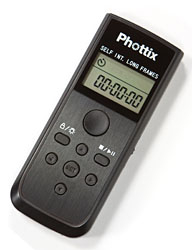
Digital Timer Remote
The Phottix Nikos Digital Timer Remote is an intervalometer, ie, a device that counts intervals of time. Specifically, it is a digital timer designed to trigger a camera shutter periodically at specified time periods.
The Nikos can be used as a simple wired shutter release for your camera, you can use the timer functionality to add a self-timer delay, or you can use the interval timer to take photos at periodic intervals (ie, time-lapse photography).
This review takes a close look at the Phottix Nikos digital timer remote, including the various timer options it supports.
Phottix is a company headquartered in Hong Kong that manufacturers many different camera accessories, providing a cheaper alternative to the genuine accessories offered by Canon, Nikon, and other camera manufacturers.
The items are manufactured in Shenzhen, China, and Phottix has offices in Hong Kong, China and Poland. Phottix has many authorised distributors in various countries, and one of the retail outlets for Phottix accessories is a sister company called HK Supplies, based in Hong Kong. HK Supplies sell cameras and accessories (Phottix and others).
The motto used by Phottix on their packaging is "You better control your camera".
Thanks to HK Supplies for providing a Phottix Nikos C8 unit for review purposes.
The Phottix Nikos Digital Timer Remote was released in October 2008 at Photokina.
The Nikos remote is labelled as "TC-501", and interestingly, while the packaging clearly labels it as a "Nikos", the "Nikos" label is absent from the remote itself, although there is a prominent "Phottix" label on the front of the remote.
The model I have for review is the Phottix Nikos C8, designed to suit Canon's N3 connector that is used by the 10D/20D/30D/40D/50D/5D and 1D cameras.
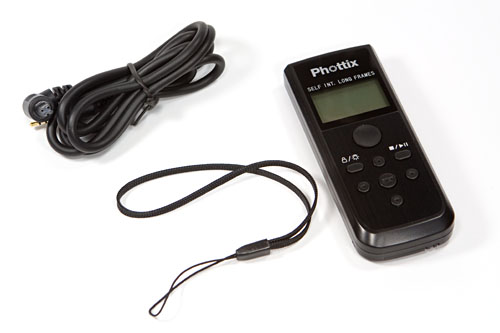
Included in the package was the Nikos timer itself, a cable to suit the Canon N3 connector, and a wrist strap. The wrist strap also allows the timer to be hung conveniently from your tripod when you're not shooting, rather than letting the remote dangle from the end of the cable.
The Phottix Nikos typically retails for about AUD$75 (approx USD$50), and the Nikos C8 model is directly competing against the much more expensive Canon TC-80N3, which sells for USD$136.95 from B&H (approx AUD$212) or AUD$280 from qualitycamera.com.au (approx USD$180).
Update: Phottix are now selling the Nikos via their recently launched their online store.
All DSLR camera manufacturers use different connectors for remotes, and Phottix have taken the sensible route to manufacture a single remote unit, and provide different cables to suit the different camera connectors. One end of the cable has a camera-specific connector, while the other end has a 2.5mm stereo connector for connecting to the Nikos remote.
The complete lineup of Phottix Nikos models is as follows:
- C8: for Canon 10D/20D/30D/40D/50D/5D/(All 1D(s) series)
- C6: for Canon 300D/350D/400D/450D/1000D and Pentax K20D, K200D, K10D, K100D
- N8: for Nikon D100/D200/D300/D700/D3
- N6: for Nikon D70s/D80
- S6: for Sony/KM cameras
The features and specifications of the Phottix Nikos digital timer remote are as follows:
Features (as listed on the packaging):
- self-timer
- exposure-count settings
- interval timer
- long-exposure timer
- optional cables for different cameras
- stylish and ergonomic design
| Dimensions | 100 x 40 x 15mm |
| Weight | 85g (includes battery) |
| Cord | about 90cm / 3ft |
| Power | CR2032 (3V) battery |
| Standby current | 10uA |
| Working current | 60uA |
| Battery life | 3 years (without using backlight) |
The switch on the right-hand side of the Nikos remote has three positions:
- Off - exactly that - turns the timer off
- On - enables timer functionality
- B - incrementing counter for long exposures using bulb mode
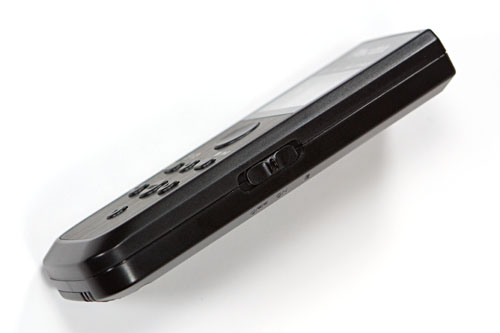
The LCD display is easy to read, and has a green backlight that can be turned on, allowing the display to be used at night.
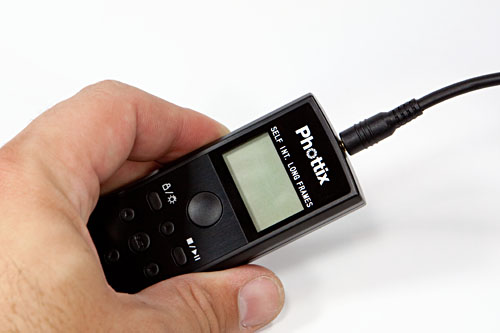
The relatively few buttons on the front of the remote provide functionality for configuring the various timer options on the Nikos. The large button near the top is the shutter release for manually triggering the camera shutter.
Note that the shutter release button on the remote is a two-stage button, simulating the camera's shutter button. A half-press will cause the camera to focus, and a full-press will actuate the camera's shutter.
The shutter button on the Nikos remote can be used when the mode switch is off, or when it is on, and will cause the camera's shutter to actuate. If the camera is in bulb mode, the camera's shutter will remain open until the button is released.
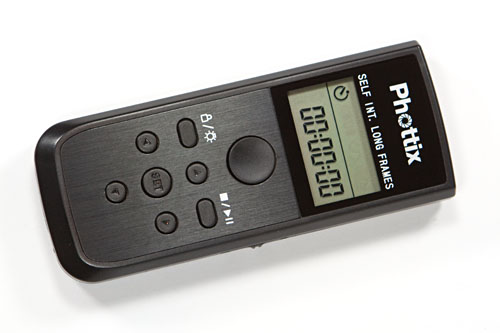
The small oval-shaped button on the left is for turning the backlight on and off, and the small oval-shaped button on the right is for starting/stopping and pausing the operation of the remote.
The "set" button alternates between viewing and changing the details on the screen, and the four cursor buttons around it are for adjusting timer intervals and navigating through the various screens.
When the mode selection switch is in the "On" position, there are four timer options that can be configured on the Nikos:
- Self Timer:
This counts down the specified period before it starts taking any action (up to 99h 59m 59s). Used by itself, this provides functionality to take a single photo after a specified time period.
- Interval Timer:
This will actuate the shutter repeatedly at the specified period (each interval can be up to 99h 59m 59s). The number of iterations is determined by the Number of Frames setting, and if the Number of Frames is set to zero, the Nikos will continue to actuate the shutter at the Interval Timer until it is stopped.
- Long Exposure Timer:
If the camera is in Bulb mode, the long exposure timer will hold the shutter open for the specified period (up to 99h 59m 59s).
- Number of Frames:
This specifies the number of shutter actuations that the Nikos will perform once it is put into play mode (0-99). When set to zero, the Nikos will continue to actuate the shutter at the Interval Timer until it is stopped.
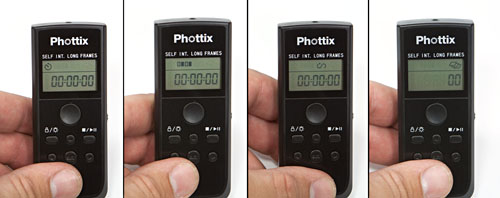
left-to-right: self timer, interval timer, long exposure timer, number of frames
The real benefit of the Nikos is when you combine multiple timer options. For example, if the Nikos is configured with the following settings:
- self timer set to 20 seconds
- interval timer set to 10 seconds
- long exposure left at zero
- frames set to 5
- count down 20 seconds (self timer)
- activate camera shutter (frame #1)
- count down 10 seconds (interval timer)
- activate camera shutter (frame #2)
- count down 10 seconds (interval timer)
- activate camera shutter (frame #3)
- count down 10 seconds (interval timer)
- activate camera shutter (frame #4)
- count down 10 seconds (interval timer)
- activate camera shutter (frame #5)
While using the Nikos remote, I identified a few short-comings:
- No instructions provided
The package I received did not contain any instructions, and the information on the packaging itself only details the features and specifications, rather than instructions on the remote's use. I was also unable to find any manuals or instructions on the web.
However, it's not very complex, and it didn't take me too long to figure out how to configure and use the Nikos remote.
Update: apparently there are instructions available for the Nikos, but when the items were packed for shipping to me, someone failed to put the instructions into the box.
Phottix have provided an electronic copy of the Nikos instructions, and have given me permission to post it here:
Phottix Nikos instructions (1.9MB PDF)
- Frame count not shown
When using the interval timer, and you've specified the number of frames you want to take, the Nikos remote only displays the interval timer on the LCD display. It would be nice if the frame counter was also displayed, to give you an indication how many frames it has taken, and how many frames are still remaining.
(This isn't relevant if the number of frames isn't specified, as the interval timer will continue to operate indefinitely until you stop/pause it.)
- Mode switch could accidentally get turned on
Depending on how you store the Nikos remote in your camera bag, there is a chance that the mode switch on the side of the unit could accidentally get turned on, thus reducing the battery life. With a specified battery life of 3 years (without using backlight), this shouldn't be too much of an issue, even if you accidentally leave it on for a few days or so.
The Phottix Nikos remote is a compact and easy-to-use remote for a DSLR. It's compact, light-weight, and should easily fit into a corner in your camera bag.
It works well as a fully-functional timer remote. Because it can also be used as a simple wired remote, there's no need to carry the Nikos and a wired remote in your camera bag - because the Nikos can function as a wired remote too.
However, the biggest benefit of the Phottix Nikos remote is that it is far cheaper than the equivalent Canon timer remote or the equivalent Nikon timer remote.
If you are looking for a timer remote for your DSLR, I can definitely recommend the Phottix Nikos digital timer remote.
The Nikos can be purchased online from Phottix's online store.
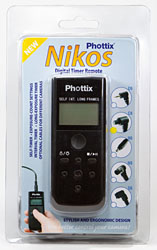
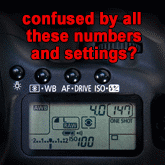


Hi,
I have been googling timer remote for my Nikon D60 but no luck. Can you help me?
Regards,
Velwin Wibowo